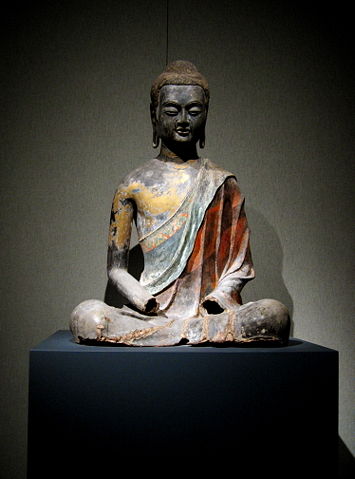Image:Mahayanabuddha.jpg
From Wikipedia, the free encyclopedia

Size of this preview: 355 × 479 pixels
Full resolution (1,493 × 2,016 pixels, file size: 961 KB, MIME type: image/jpeg)
File history
Click on a date/time to view the file as it appeared at that time.
| Date/Time | Dimensions | User | Comment | |
|---|---|---|---|---|
| current | 02:37, 19 January 2007 | 1,493×2,016 (961 KB) | Sandrog | (From Hebei, Tang Dynasty. The MET Seated Buddha, Tang dynasty, ca. 650 China Dry lacquer with traces of gilt and polychrome pigments; H. 38 in. (96.5 cm); W. 27 in. (68.6 cm) Rogers Fund, 1919 (19.186) Buddhist images executed in dry lacquer were hi) |
File links
The following pages on Schools Wikipedia link to this image (list may be incomplete):
Metadata
This file contains additional information, probably added from the digital camera or scanner used to create or digitize it. If the file has been modified from its original state, some details may not fully reflect the modified file.
| Camera manufacturer | Canon |
|---|---|
| Camera model | Canon DIGITAL IXUS 400 |
| Exposure time | 1/10 sec (0.1) |
| F-number | f/2.8 |
| Date and time of data generation | 17:52, 30 December 2005 |
| Lens focal length | 7.40625 mm |
| Orientation | Normal |
| Horizontal resolution | 72 dpi |
| Vertical resolution | 72 dpi |
| Software used | QuickTime 7.0.4 |
| File change date and time | 22:06, 14 January 2006 |
| Y and C positioning | 1 |
| Exif version | 2.2 |
| Date and time of digitizing | 17:52, 30 December 2005 |
| Image compression mode | 3 |
| Shutter speed | 3.3125 |
| Aperture | 2.96875 |
| Maximum land aperture | 2.96875 |
| Metering mode | Pattern |
| Flash | 16 |
| Colour space | sRGB |
| Focal plane X resolution | 8114.28571429 |
| Focal plane Y resolution | 8114.28571429 |
| Focal plane resolution unit | inches |
| Sensing method | One-chip colour area sensor |
| Custom image processing | Normal process |
| Exposure mode | Manual exposure |
| White balance | Manual white balance |
| Digital zoom ratio | 1 |
| Scene capture type | Standard |
